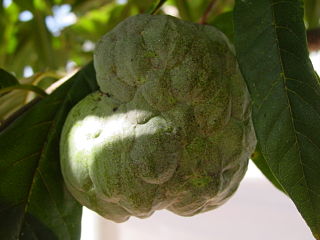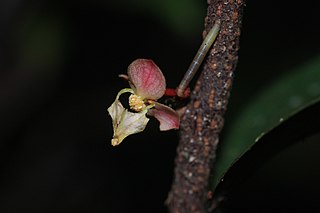
The Annonaceae are a family of flowering plants consisting of trees, shrubs, or rarely lianas commonly known as the custard apple family or soursop family. With 108 accepted genera and about 2400 known species, it is the largest family in the Magnoliales. Several genera produce edible fruit, most notably Annona, Anonidium, Asimina, Rollinia, and Uvaria. Its type genus is Annona. The family is concentrated in the tropics, with few species found in temperate regions. About 900 species are Neotropical, 450 are Afrotropical, and the remaining are Indomalayan.

Cissus is a genus of approximately 350 species of lianas in the grape family (Vitaceae). They have a cosmopolitan distribution, though the majority are to be found in the tropics.

Mitrephora is a genus of flowering plants in the family Annonaceae, that are native to an area that extends from China in the north to Queensland. Plants in the genus Mitrephora are also found in southern India and Southeast Asia.

Alphonsea is a genus of plant in the family Annonaceae. As of April 2014 The Plant List recognises 38 accepted species:

Canthium is a genus of flowering plants in the family Rubiaceae. They are shrubs and small trees. The leaves are deciduous and the stems are usually thorny.

Fissistigma is a genus of flowering plants in the family Annonaceae. There are 59 species distributed in Africa, Asia and Oceania.

Goniothalamus is one of the largest palaeotropical genera of plant in family Annonaceae.

Miliusa is a genus of plants in family Annonaceae. Species have been recorded from tropical and subtropical Asia to northern Australia.

Orophea is a genus of flowering plants in the family Annonaceae. There are about 60 species, native to Asia.

Phaeanthus is a genus of plants in family Annonaceae native to Indo-China, Malesia and the island of New Guinea.

Uvaria is a genus of flowering plants in the family Annonaceae. The generic name uvaria is derived from the Latin uva meaning grape, likely because the edible fruit of some species in the genus resemble grapes.

Meiogyne is a genus of flowering plants with 38 species belonging to the family Annonaceae. It is native from southwestern India and Indochina to Australia, including Fiji and New Caledonia. The type species is Meiogyne virgata.

Artabotrys is a genus of plants in the Annonaceae family. There are over 100 species in the Old World tropics, with 31 species in Africa. It is part of the custard apple family (Annonaceae). All species are small trees or shrubs with a tendency to climb. Leaves are simple and alternate, without hairs. Bisexual flowers are borne singly or in clusters opposite the leaves. The 6-petalled flowers are scented, and the plant bears fleshy fruits.

Monoon coffeoides is a species of plant in the Annonaceae family. It is a synonym of Polyalthia coffeoides and found in southern India and Sri Lanka.

Huberantha is a genus of plants in the family Annonaceae and tribe Miliuseae. It is distributed in Australia, tropical Asia, East Africa and some Pacific islands. Tanawat Chaowasku named the genus "Huber's flowers" in honor of the German botanist Herbert Huber and to highlight its flowers as a distinguishing feature of the genus. A number of species have been moved here from the genus Polyalthia.

Monoon is a genus of plants in the family Annonaceae and the tribe Miliuseae. Species have been recorded from the Indian subcontinent, Indo-China, Malesia, New Guinea and Australia, with introductions in West Africa. A number of species have been moved here from the genus Polyalthia.

The Malmeoideae are a subfamily of trees and other plants of the family Annonaceae.

Dasymaschalon is an Asian genus of bushy plants in the subfamily Annonoideae and tribe Uvarieae. Its native range is from southern China, Indo-China to Malesia.



















